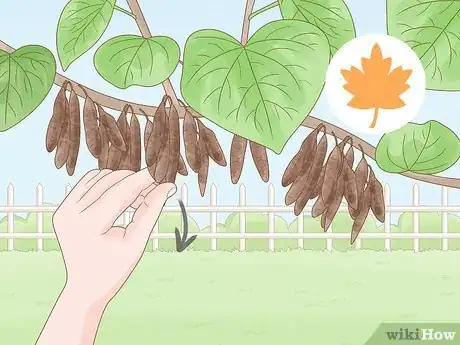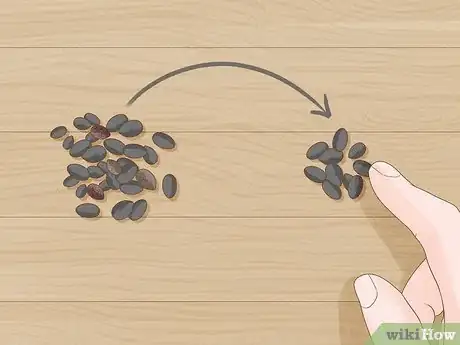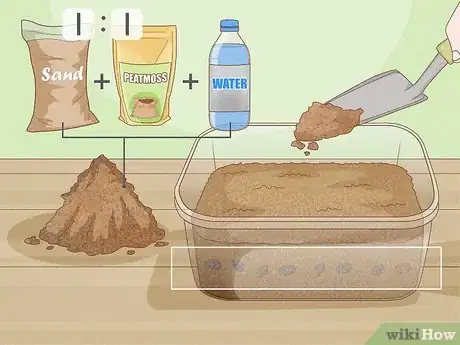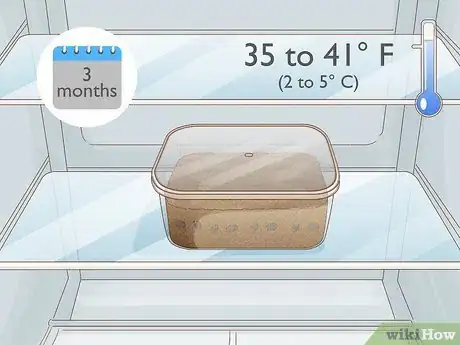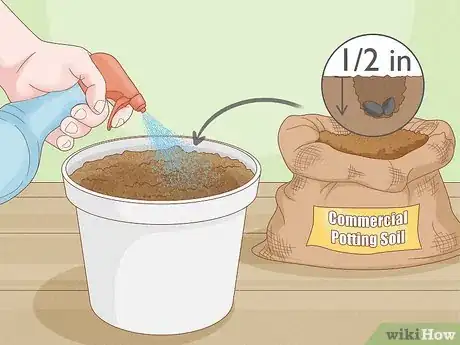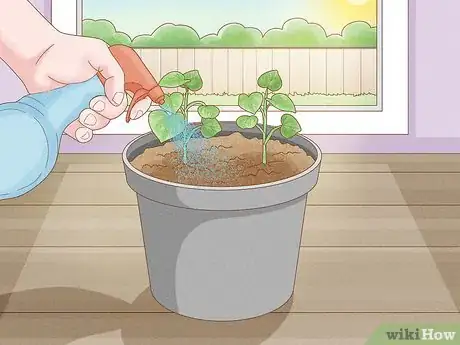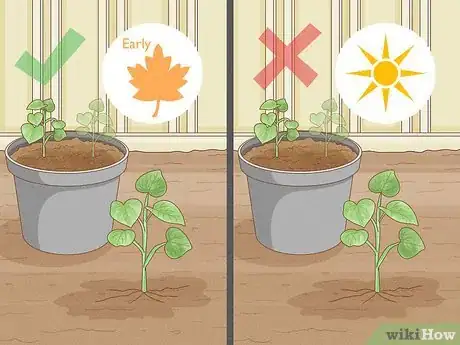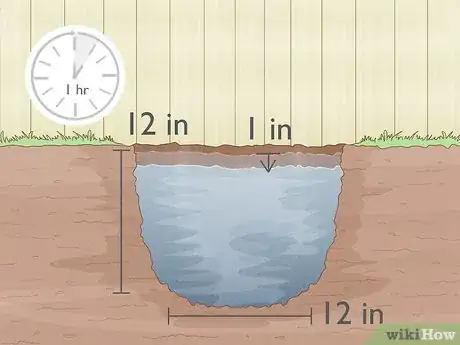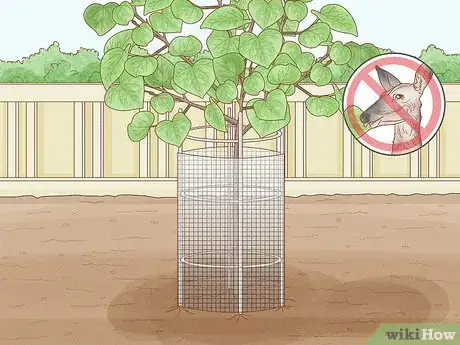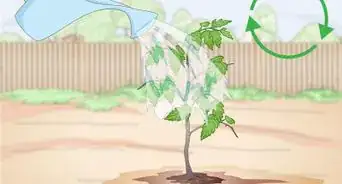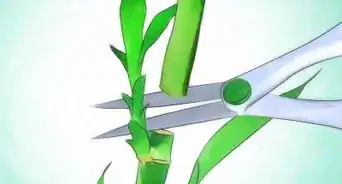This article was co-authored by wikiHow staff writer, Megaera Lorenz, PhD. Megaera Lorenz is an Egyptologist and Writer with over 20 years of experience in public education. In 2017, she graduated with her PhD in Egyptology from The University of Chicago, where she served for several years as a content advisor and program facilitator for the Oriental Institute Museum’s Public Education office. She has also developed and taught Egyptology courses at The University of Chicago and Loyola University Chicago.
There are 17 references cited in this article, which can be found at the bottom of the page.
This article has been viewed 16,563 times.
Learn more...
The eastern redbud tree, also known as the American redbud, or Cercis canadensis, is an attractive flowering tree or shrub. With a little patience and preparation, you can germinate and grow a redbud tree from seed. If you’re interested in growing one of these pretty plants in your own garden or incorporating it into a landscaping project, read on! We’ll talk you through how to sprout the seeds and care for the seedlings once they start to grow.
Steps
Germinating the Seeds
-
1Collect the seed pods in fall when they turn brown. If you have access to local redbud trees, the easiest way to get seeds is to harvest them yourself. When autumn comes around, watch for the pods on the redbud trees to turn dark brown. Break off the pods by hand, or trim them off the tree with scissors or sheers.[1]
- You can also collect redbud seed pods in the winter, but it’s generally best to collect them earlier to avoid insect damage.[2]
- Collecting seeds locally ensures that you’ll get a strain that’s hardy in your climate zone. The eastern redbud is hardy in zones 4 to 9, but there are a few related redbud varieties that will only grow in warmer climates.[3]
- Alternatively, purchase redbud seeds online or from a garden center. Do a search using terms like “buy eastern redbud seeds.”
-
2Peel the pods open and remove the seeds. Redbud seed pods look very similar to snap pea pods, since redbuds are members of the pea family.[4] Once you’ve gathered the pods, peel them apart and pull the seeds out, just like you would with a pea pod.[5]
- Air-drying the pods first can make it easier to break them open so you can collect the seeds. If you choose to do this, spread the pods evenly on a screen and leave them in a dry place for a few days, until they feel hard and dry.[6]
Advertisement -
3Select large, healthy-looking seeds. Ripe redbud seeds are brown and flat, with a very hard outer covering. Throw away any seeds that appear discolored, shriveled, or misshapen. Also discard any seeds that have tiny holes in them, since this could mean that they have been damaged by weevils or other insects.[7]
- For the best chance of success, collect several seeds instead of just 1 or 2. You’ll be more likely to get some viable seedlings that way.
- You can also check whether the seeds are viable by tossing them into a container of water. Good seeds will sink, while bad ones will float.[8]
-
4Submerge the seeds in boiling water for 1 minute. Redbud seeds have an extremely hard coating that must be broken before they will sprout. This process is called scarifying the seeds. One easy way to do this is to boil the seeds for no more than 1 minute.[9] Some horticulture experts recommend allowing the seeds to soak in the water overnight or for as long as 24 hours after switching off the heat.[10] Alternatively, you can scarify the seeds by:
- Nicking or scoring the outside of the seed with a sharp knife.[11]
- Rubbing the outside of the seed with sandpaper.[12] Rub the seed for about 30 seconds to 1 minute to ensure that you wear through the outer coating.[13]
- Soaking the seeds for about 30 minutes in concentrated sulfuric acid.[14] However, only use this method if you have access to proper safety equipment, such as a fume hood.[15]
-
5Cover the seeds with moist sand and peat moss. Mix 1 part sand and 1 part peat moss and mix in enough water so that the mixture is moist, but not soaking wet. Sprinkle a thin layer of the mixture over the bottom of a plastic container with a lid, such as a small Tupperware tub or margarine container. Place a layer of seeds evenly on top of the layer of sand and peat moss, then add more of the mixture until the seeds are completely covered. Put the lid on the container.[16]
- Some gardeners recommend poking 1 or 2 holes in the lid of the container to provide ventilation.[17]
- If you don’t have a plastic tub, simply toss the seeds into a zipper-top bag with some moist, soil-free growing medium, such as vermiculite or pearlite.[18]
- The sand and peat moss mixture will help keep the seeds moist without making them soggy. Placing the seeds in a cool, moist medium will also simulate the natural conditions of an outdoor winter, which is an important part of their life cycle.
-
6Refrigerate the seeds for 90 days. Redbud seeds need to stay cold for several weeks before they can begin to grow. To mimic the plant’s natural life cycle, place the container with the growing medium and seeds in your fridge for about 3 months. This process is called “cold stratification.”[19]
- Make sure your fridge is set between 35 and 41 °F (2 and 5 °C), which is the optimal temperature range for redbud stratification.
-
7Sow the seeds 1⁄2 inch (1.3 cm) deep in potting mix. After 90 days have passed, transfer the seeds to a pot filled with commercial potting soil. Use a soil mixture that contains a 1:1 mix of sand and peat moss. Poke a few 1⁄2 in (1.3 cm) holes in the soil and drop 2 seeds into each hole, then fill in the holes with the soil mixture. Dampen the soil with water from a spray bottle.[20]
- You can also sow the seeds directly in the ground in fall or spring.[21] However, your seedlings are more likely to survive if you start them indoors.
- If you started your seeds in a seedling tray, move them to individual pots after they have a few true leaves.
Caring for the Seedlings
-
1Keep your saplings in a sunny spot. Place your pot or nursery container in a sunny window where it will get plenty of light. If the weather is warm, you can put the also put the container outdoors so that the baby trees get direct sunlight.[22]
- If there’s a danger of frost, keep the seedlings indoors so their roots don’t freeze.
-
2Water the seedlings once a week. Keep the soil moist, but not soaking wet. Redbuds don’t do well in soggy soil. You might find it helpful to use a spray bottle to dampen the soil.[23]
-
3Transfer the tree to the ground when it’s 12–18 inches (30–46 cm) tall. To plant your baby redbud, dig a hole with sloping sides that’s about 3-4 times wider than the pot and as deep as the soil in the pot. Remove the tree and soil from the pot and set it in the middle of the hole. Fill in the hole and pack the soil down around the tree, leaving the tops of the roots at the base of the trunk exposed.[24]
-
4Move the redbud outside in early fall. You can plant your tree outside any time except the summer months, but early fall is usually the best time to plant a redbud. This will give your tree a chance to establish some stronger roots before it goes dormant for the winter.[26]
- Avoid planting your redbud in the summer, since hot and dry conditions can be stressful for a young tree.
-
5Pick a sunny, well-drained spot. Redbuds like lots of sun, so pick an area with full sun or partial shade. Before you plant the tree, check that the soil drains well and doesn’t get soggy.[27]
- To check your soil drainage, dig a hole that’s about 12 inches (30 cm) wide and 12 inches (30 cm) deep. Fill it with water and see how fast it drains. The water level should go down by about 1 inch (2.5 cm) per hour.[28]
-
6Water the tree at least once a week for about 1 year. For the first year or so of your redbud’s life, it will need to be watered frequently. A good rule of thumb is to water it every 7 days until it is a year old.[29]
- Your baby redbud will need even more water for the first few weeks after you plant it. Water it daily for the first 1-2 weeks, then every 2-3 days for the next 10 weeks. After 12 weeks, you can switch to watering once a week.[30]
-
7Put a barrier around the tree to protect it from deer. Baby redbud trees are susceptible to damage from deer and other animals until they’re about 6 feet (1.8 m) tall. To keep your tree safe as it grows, put some kind of barrier around it, such as a small fence or a mesh tree guard.[31]
- Redbuds grow at a medium rate of about 13–24 inches (33–61 cm) per year. It may take around 5 years for your tree to get tall enough so that it no longer needs protection.[32]
- A mature redbud can grow to about 20–30 feet (6.1–9.1 m) high. Unfortunately, these trees have fairly short lifespans, and typically begin to die after about 20 years.[33]
Expert Q&A
-
QuestionHow do you make a tree stronger?
 Mike GarciaMike Garcia is a Licensed Landscape Contractor and the Founder of Enviroscape LA, a full-service landscape design and construction firm in Los Angeles, California. With over 30 years of experience, Mike specializes in sustainable landscape practices. Mike holds an Ornamental Horticulture degree, C-27 Landscape Contractor and D-49 Tree Service Contractor licenses, and Permaculture Design, California Naturalist, International Certified Professional Pond Contractor, and Pond Building certifications. He is one of eight Internationally Certified Pond Builders in the world. Enviroscape LA has won landscape and water feature awards from the International Professional Pond Contractors Association (IPPCA), National Association of Pond Professionals (NAPP), and the California Landscape Contractors Association (CLCA). Mike is a past president of the CLCA and currently serves on their local Board of Directors. Enviroscape LA has been featured in PONDS USA Magazine, Pond and Garden Lifestyles Magazine, and the Los Angeles Times. Mike has appeared on Extreme Home Makeover, HGTV's Landscapers Challenge, and A & E's series Fix That Yard.
Mike GarciaMike Garcia is a Licensed Landscape Contractor and the Founder of Enviroscape LA, a full-service landscape design and construction firm in Los Angeles, California. With over 30 years of experience, Mike specializes in sustainable landscape practices. Mike holds an Ornamental Horticulture degree, C-27 Landscape Contractor and D-49 Tree Service Contractor licenses, and Permaculture Design, California Naturalist, International Certified Professional Pond Contractor, and Pond Building certifications. He is one of eight Internationally Certified Pond Builders in the world. Enviroscape LA has won landscape and water feature awards from the International Professional Pond Contractors Association (IPPCA), National Association of Pond Professionals (NAPP), and the California Landscape Contractors Association (CLCA). Mike is a past president of the CLCA and currently serves on their local Board of Directors. Enviroscape LA has been featured in PONDS USA Magazine, Pond and Garden Lifestyles Magazine, and the Los Angeles Times. Mike has appeared on Extreme Home Makeover, HGTV's Landscapers Challenge, and A & E's series Fix That Yard.
Licensed Landscape Contractor Make the conditions around your tree great for mycorrhizal fungi. This fungi helps pull nutrients up from deep within the soil where trees can't reach. Then, the fungi trades the nutrients for the sugar and carbohydrates that the tree makes through photosynthesis.
Make the conditions around your tree great for mycorrhizal fungi. This fungi helps pull nutrients up from deep within the soil where trees can't reach. Then, the fungi trades the nutrients for the sugar and carbohydrates that the tree makes through photosynthesis.
Things You’ll Need
Germinating the Seeds
- Redbud seed pods
- Pot for boiling water
- Sandpaper or sharp knife (alternative to boiling water)
- Soil-free growing mix (such as vermiculite or sand and peat moss)
- Small plastic container with lid
- Pot or seedling tray
- Commercial potting mix with sand and peat moss
- Spray bottle
Caring for the Seedlings
- Plant pot
- Mulch
- Mesh tree barrier or fencing material
References
- ↑ https://www.uky.edu/hort/sites/www.uky.edu.hort/files/pages-attachments/Species%20descriptions.pdf
- ↑ https://assets.speakcdn.com/assets/2227/redbud_fact_sheet.pdf
- ↑ https://hort.extension.wisc.edu/articles/eastern-redbud-cercis-canadensis/
- ↑ https://mbgna.umich.edu/native-plant-of-the-week-eastern-redbud/
- ↑ https://www.uky.edu/hort/sites/www.uky.edu.hort/files/pages-attachments/Species%20descriptions.pdf
- ↑ https://www.nrcs.usda.gov/Internet/FSE_PLANTMATERIALS/publications/wvpmcot12016.pdf
- ↑ https://www.uky.edu/hort/sites/www.uky.edu.hort/files/pages-attachments/Species%20descriptions.pdf
- ↑ https://www.wildflower.org/expert/show.php?id=1823&frontpage=true
- ↑ https://hortnews.extension.iastate.edu/faq/how-can-i-germinate-redbud-seeds
- ↑ https://www.wildflower.org/expert/show.php?id=306
- ↑ https://www.wildflower.org/expert/show.php?id=1823&frontpage=true
- ↑ https://waterlandlife.org/tree-planting-instructions/
- ↑ https://www.missouribotanicalgarden.org/Portals/0/Shaw%20Nature%20Reserve/PDFs/horticulture/Propagation.pdf
- ↑ https://assets.speakcdn.com/assets/2227/redbud_fact_sheet.pdf
- ↑ https://www.wildflower.org/expert/show.php?id=1823&frontpage=true
- ↑ https://hortnews.extension.iastate.edu/faq/how-can-i-germinate-redbud-seeds
- ↑ https://aggie-horticulture.tamu.edu/newsletters/hortupdate/2010/jun/tree_seeds.html
- ↑ https://waterlandlife.org/tree-planting-instructions/
- ↑ https://waterlandlife.org/tree-planting-instructions/
- ↑ https://waterlandlife.org/tree-planting-instructions/
- ↑ https://www.wildflower.org/expert/show.php?id=6883
- ↑ https://waterlandlife.org/tree-planting-instructions/
- ↑ https://waterlandlife.org/tree-planting-instructions/
- ↑ https://www.arborday.org/trees/planting/containerized.cfm
- ↑ https://waterlandlife.org/tree-planting-instructions/
- ↑ https://www.wildflower.org/expert/show.php?id=6883
- ↑ https://waterlandlife.org/tree-planting-instructions/
- ↑ http://agebb.missouri.edu/agforest/archives/v10n2/gh14.htm
- ↑ https://www.arborday.org/trees/planting/containerized.cfm
- ↑ https://extension.umn.edu/planting-and-growing-guides/watering-newly-planted-trees-and-shrubs
- ↑ https://waterlandlife.org/tree-planting-instructions/
- ↑ https://www.arborday.org/trees/treeguide/TreeDetail.cfm?ItemID=912
- ↑ https://hgic.clemson.edu/factsheet/redbud/
